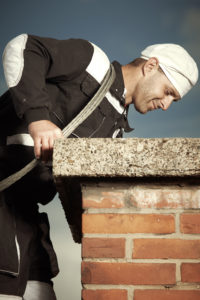Does your chimney need to be relined?
 As chimneys across the country undergo their annual inspections in preparation for the winter, it’s a fair bet that several homeowners will hear that their chimneys need new liners. But what does that really mean? Why do chimney liners need to be replaced? What are the options for replacing a chimney liner?
As chimneys across the country undergo their annual inspections in preparation for the winter, it’s a fair bet that several homeowners will hear that their chimneys need new liners. But what does that really mean? Why do chimney liners need to be replaced? What are the options for replacing a chimney liner?
Chimney liners: A closer look
As the name suggests, the chimney liner contours the inside of your chimney flue. It insulates your fireplace from the rest of your home, keeping in the heat and smoke. Chimney liners also protect the chimney structure from corrosion caused by soot. Chimney can also help to properly size a chimney to improve its draft. In many homes, chimney liners are built from clay tiles. In other homes, the chimney liners are metal, generally either stainless steel or aluminum.
Why chimney liners need to be replaced
Chimney liners are incredibly durable. They’re made to stand up to the heat of your fireplace. Regardless, chimney liners do break down over time. Aluminum chimney liners especially will show their wear quickly. Clay tiles can crack over time, as they come into contact with moisture and heat, and the mortar joints between the tiles can crumble away, leaving gaps within the fireplace flue. Even stainless steel chimney liners are not impervious to wear and tear over time.
A weakened chimney liner can cause a major hazard in your home. Cracks or holes within the liner can allow the heat, and potentially embers from your fireplace to heat your home’s surrounding structure. That puts your home at risk of structural damage or a home fire. Faults in the chimney liner also can allow carbon monoxide to escape the chimney and put your family in danger.
Options for replacing your chimney liner
When it comes to relining a chimney, there are two methods chimney sweeps prefer to use. First, a chimney can be relined with an aluminum or stainless steel chimney liner. If there is an existing metal chimney liner, that will be removed, and the new chimney liner, properly sized for your flue, will be inserted.
The other option for relining a damaged tile chimney liner is HeatShield Cerfractory Sealant. HeatShield is a pourable substance made from ceramic and cerfractory cement, which makes it strong and durable. When relining your chimney with HeatShield, a custom made foam applicator is lowered down your chimney. The HeatShield is poured in, and the foam applicator is pulled up, smoothing the HeatShield into place. Depending on the severity of your chimney liner’s deterioration, multiple layers of HeatShield or different HeatShield products might be used to restore your liner.
Need a new liner? Call Your Chimney Sweep!
If your chimney needs to be relined in preparation for the winter, call Your Chimney Sweep to schedule your appointment! We will inspect your chimney and recommend the best option for relining. We can then restore your chimney’s function with a new metal or HeatShield liner!
